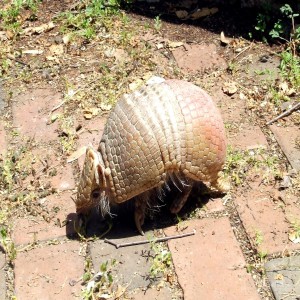Hairy Armadillo
[Chaetophractus vellerosus]

The Hairy Armadillo weighs around 1.5 pounds. Its armor consists of the shield on the head, a small shield between the ears on the back of the neck, and the carapace which protects the shoulders, back, sides and rump. The banded portion of the armored shell (carapace) has about 18 bands, of which usually 7 to 8 are movable. These animals have more hair than most armadillos.
Location: Education Animals
Share:
Range
Hairy Armadillos are found in Western Bolivia, Paraguay and Central Argentina.
Habitat
Hairy armadillos inhabit semi-desert conditions in open areas.
Conservation Status
Least ConcernPrimary Threats
Illegal Wildlife Trade, mining and quarrying of sand for concrete production, and they are also considered an agricultural pest.Gestation
Gestation in hairy armadillos takes 60-75 days.
Litter
Hairy armadillos usually have two in a litter.
Behavior
The Hairy Armadillo usually inhabits open areas and they seem best adapted to semi-desert conditions. They are powerful diggers and live in burrows. The burrows are usually on sloping sand dunes and are several meters long and more than a meter deep. Activity is largely nightly (nocturnal) in summer, to avoid the desert heat, and during the day (diurnal) in winter. When threatened, they often emit a loud squeal. If unable to find a hole, they try to burrow into the ground. If overtaken while running, or if they do not have a chance to burrow, they draw in their feet so that the edges of their armor are in contact with the ground, and thus protect themselves against canid and avian predators. They anchor themselves in their burrows by spreading their feet sideward and bending their bodies so that the free hind edges of the bands grasp the walls of the burrow.
Reproduction
Hairy Armadillos usually mate in September. They can average more than one litter a year. Litters usually consist of two young, often one male and one female. The young weigh about 5.4 ounces at birth, open their eyes after 16 to 30 days, and reach sexual maturity at 9 months.
Wild Diet
Grubs, insects, small rodents and lizards, plant material in winter
